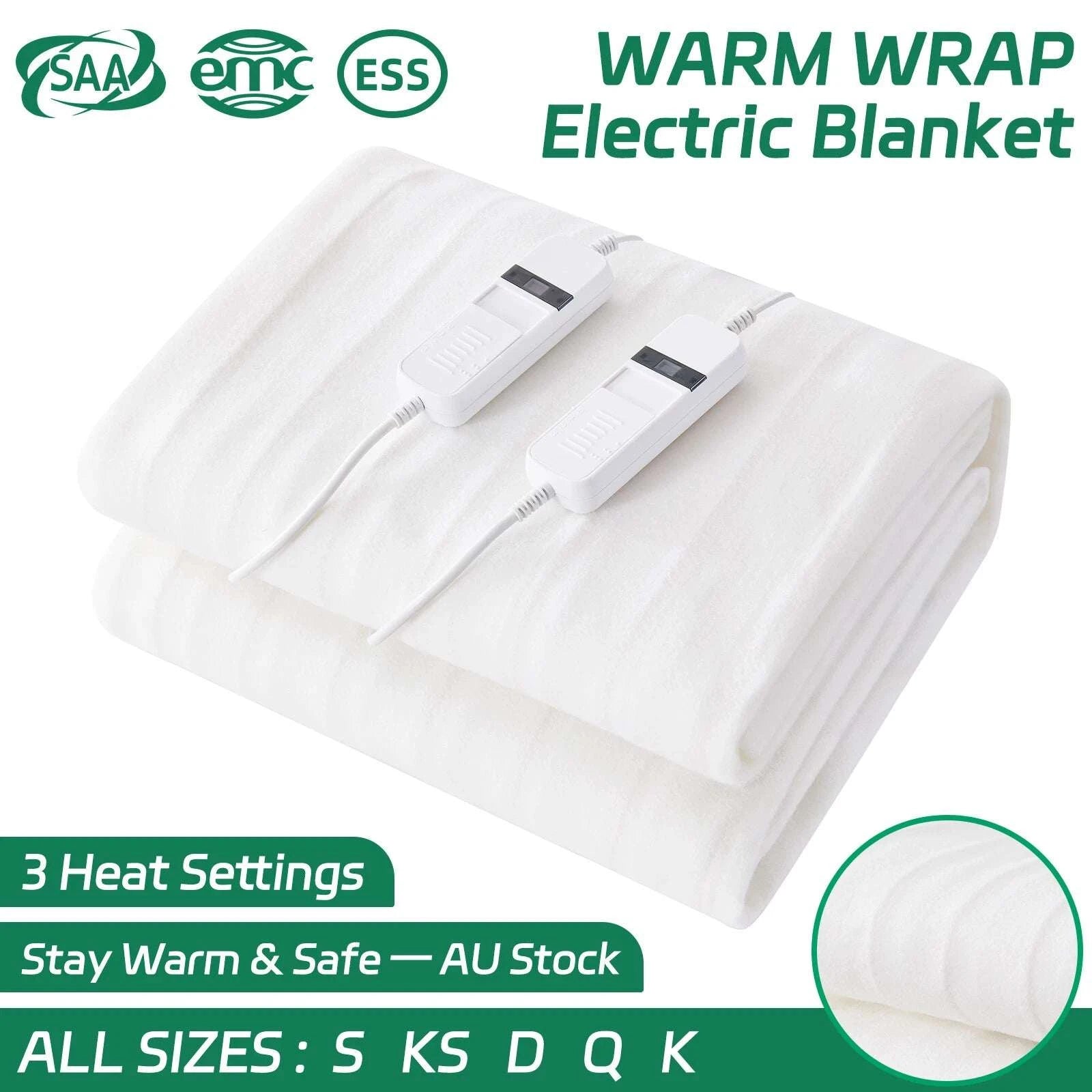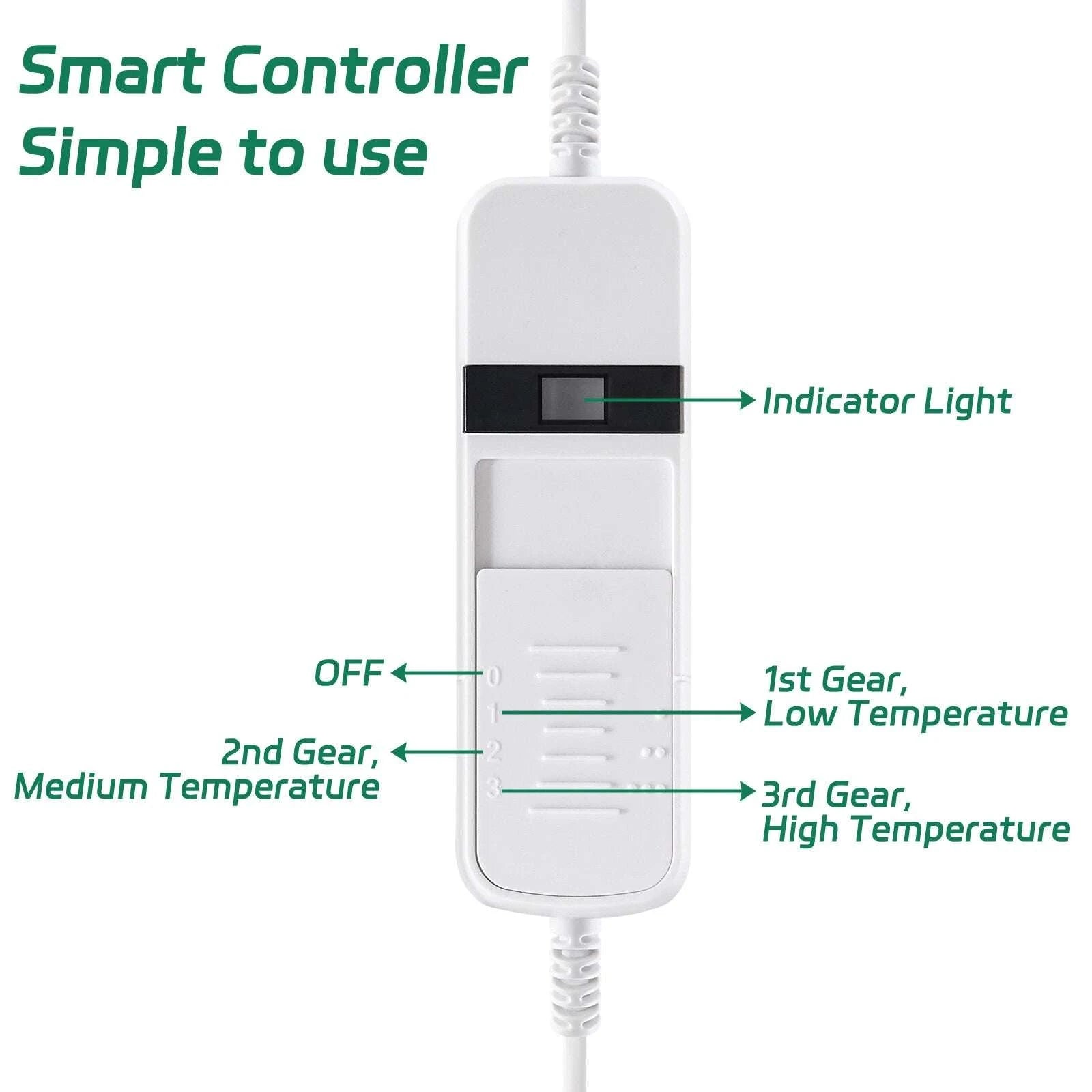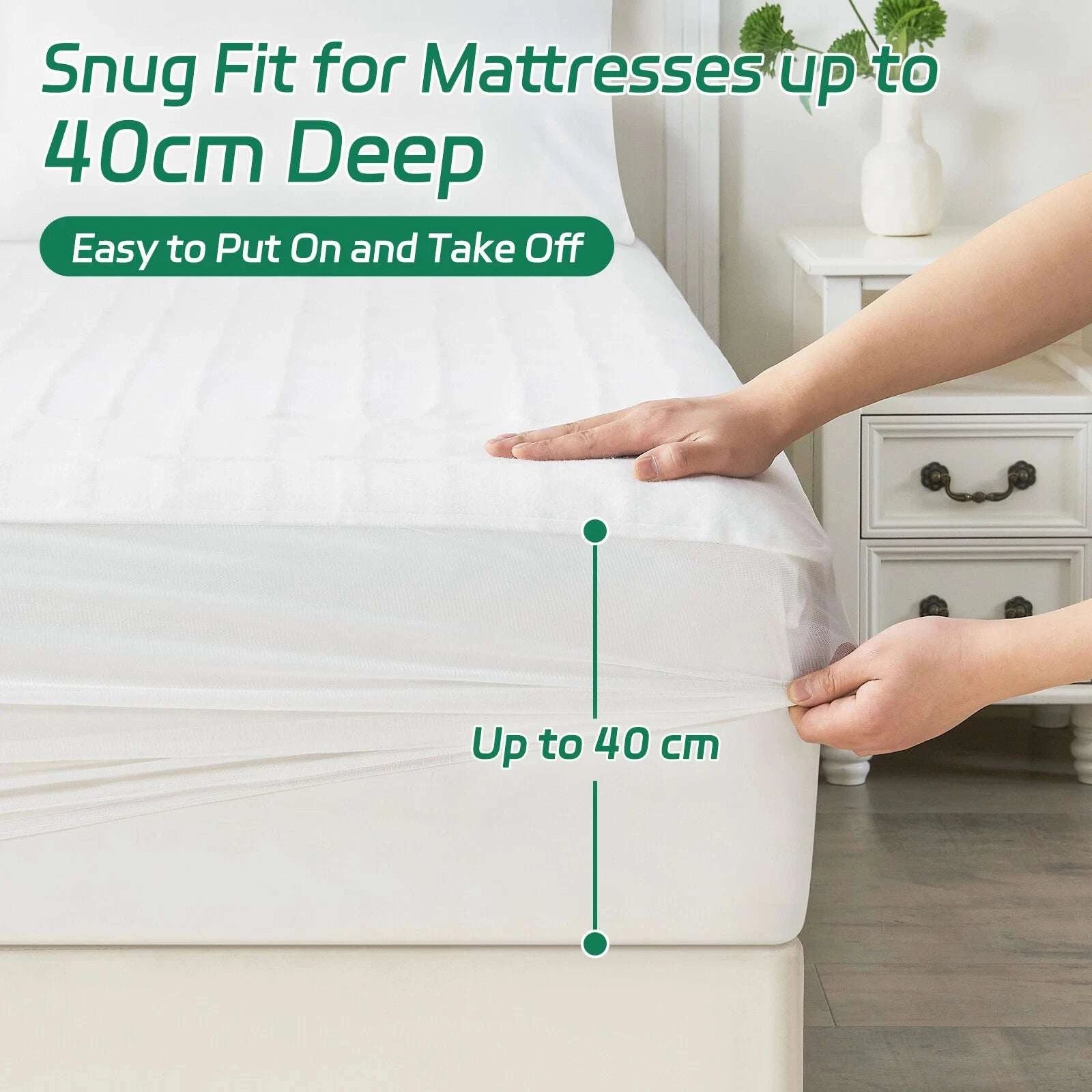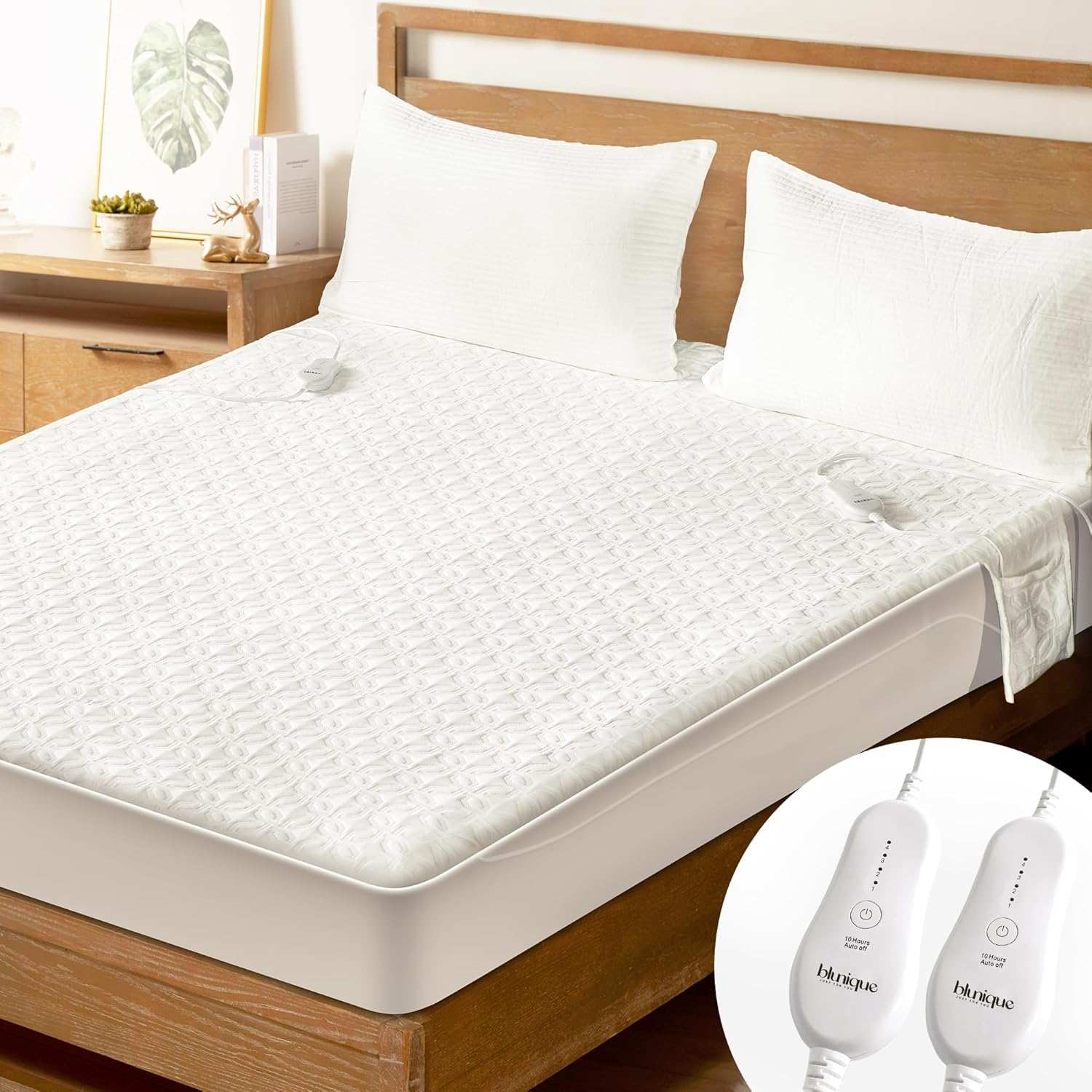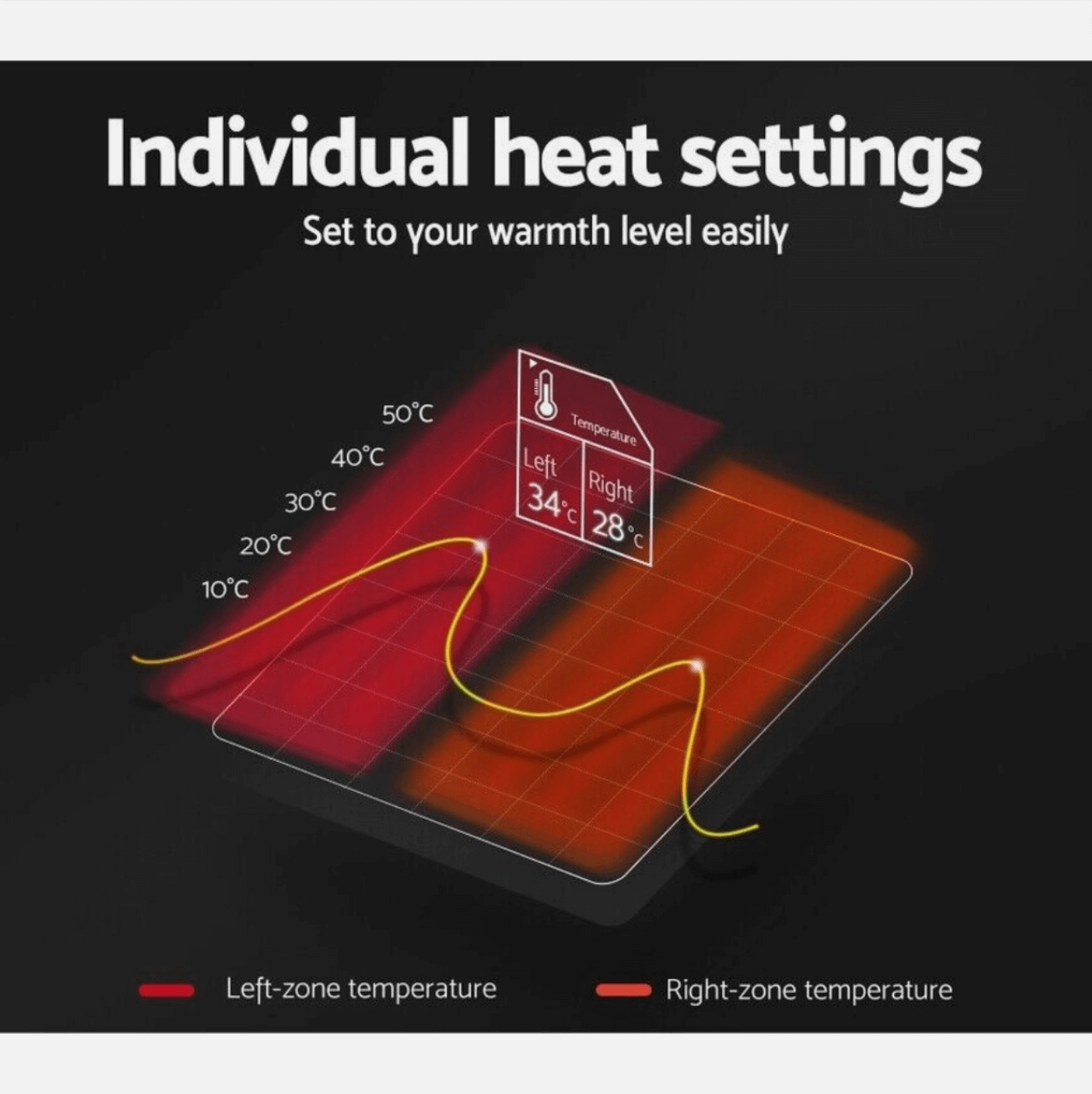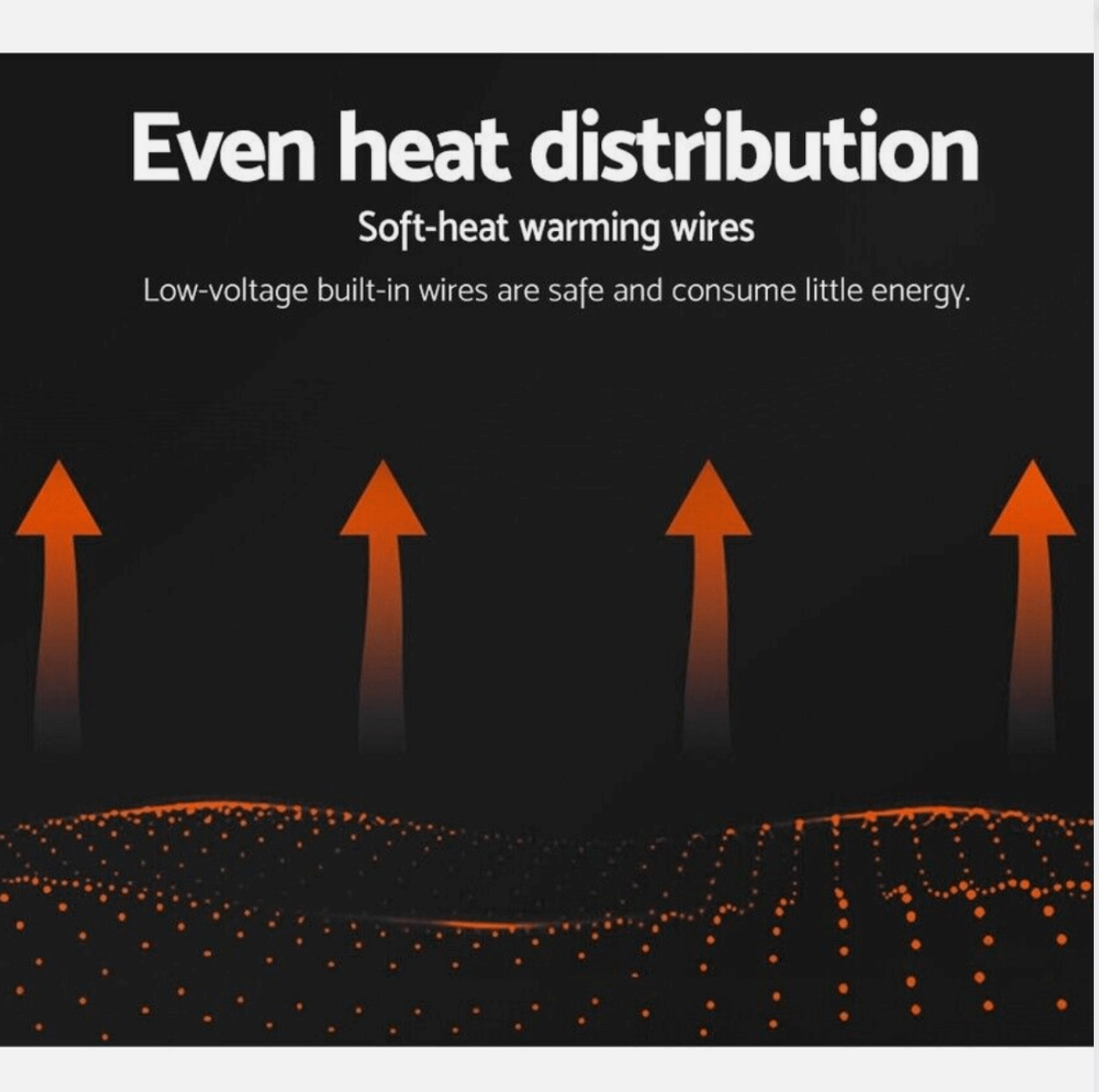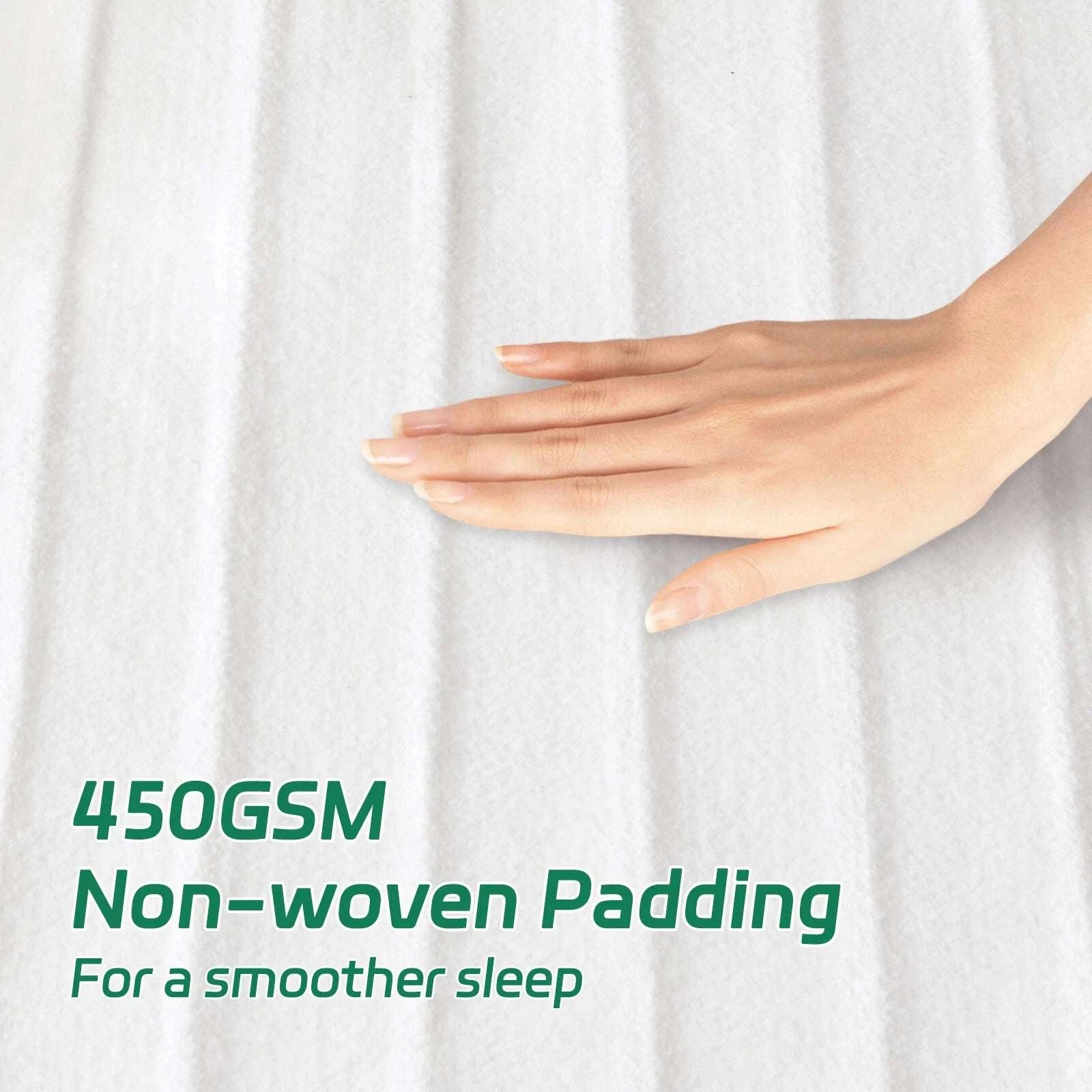How to Wash, Store & Maintain Electric Blankets
Complete Australian Care Guide 2025
Proper care and maintenance of electric blankets is essential for safety, performance, and longevity. In Australia's diverse climate conditions, from tropical humidity in the north to alpine cold in the south, electric blankets face unique challenges that require specific care approaches. A well-maintained electric blanket can last 8-12 years, while poor care can lead to premature failure, safety hazards, and voided warranties.
This comprehensive guide provides step-by-step instructions for washing, storing, and maintaining electric blankets, with specific considerations for Australian climate conditions, brand requirements, and safety standards. Whether you're dealing with Melbourne's unpredictable weather, Brisbane's humidity, or Perth's dry heat, these guidelines will help you keep your electric blanket in optimal condition year-round.
⚠️ Safety First
Always disconnect electric blankets from power and remove all electrical components before washing or cleaning. Never immerse electrical controls in water, and always check manufacturer instructions before proceeding with any maintenance. When in doubt, consult the manufacturer or consider professional cleaning services.
Table of Contents
Complete Washing Guide
Washing electric blankets requires careful attention to detail and adherence to specific procedures to maintain safety and functionality. The process varies depending on the blanket type, brand, and age, but certain fundamental principles apply to all electric blankets sold in Australia.
Pre-Washing Preparation
Before beginning the washing process, thorough preparation is essential for both safety and effectiveness. Start by completely disconnecting the electric blanket from all power sources and removing any detachable controllers or cords. These electrical components should never come into contact with water and must be stored safely during the washing process.
Inspect the blanket carefully for any signs of damage, including frayed wires, burn marks, or areas where the internal heating elements may be exposed. If any damage is detected, do not proceed with washing. Instead, contact the manufacturer or consider replacement, as washing a damaged electric blanket can worsen existing problems and create safety hazards.
Check the care label thoroughly, as different manufacturers and models may have specific requirements that override general guidelines. Australian electric blanket manufacturers are required to provide clear care instructions, and following these exactly is crucial for maintaining warranty coverage and ensuring safe operation.
Step-by-Step Washing Process
- Disconnect and Remove Controls: Unplug the blanket from the wall outlet and carefully disconnect all electrical controls and cords. Store these components in a dry, safe location away from the washing area.
- Pre-treat Stains: Address any visible stains with a mild, non-bleach stain remover. Apply gently and allow to sit for 10-15 minutes before washing. Avoid harsh chemicals that could damage the blanket's fabric or internal components.
- Load the Washing Machine: Place the blanket in the washing machine alone, without other items. Ensure the machine is large enough to allow the blanket to move freely without bunching or folding excessively.
- Select Appropriate Settings: Use cold or lukewarm water (maximum 30°C) and select a gentle or delicate cycle. Avoid hot water, which can damage internal wiring and shrink fabric components.
- Add Mild Detergent: Use a small amount of mild, liquid detergent. Avoid fabric softeners, bleach, or harsh chemicals that can coat wires or damage electrical insulation.
- Monitor the Cycle: Check periodically to ensure the blanket isn't bunching or creating excessive strain on any particular area. If necessary, pause the cycle to redistribute the blanket.
- Extra Rinse: Run an additional rinse cycle to ensure all detergent is removed, as residue can affect the blanket's electrical properties and cause skin irritation.
- Gentle Spin: Use the lowest spin setting to minimize stress on internal wiring. High-speed spinning can damage delicate electrical components.
Hand Washing Alternative
For delicate or older electric blankets, hand washing may be the safest option. This method provides maximum control over the washing process and minimizes stress on internal components. Fill a large bathtub or basin with cool water and a small amount of mild detergent, ensuring the water temperature doesn't exceed 30°C.
Submerge the blanket completely and gently agitate by hand, paying particular attention to soiled areas. Avoid wringing, twisting, or applying excessive pressure that could damage internal wiring. Allow the blanket to soak for 10-15 minutes, then drain the soapy water and refill with clean water for rinsing.
Rinse thoroughly, changing the water multiple times until no soap residue remains. The final rinse water should run completely clear. Gently press out excess water without wringing or twisting the blanket, then proceed to the drying phase.
| Washing Method | Water Temperature | Cycle Type | Detergent | Best For |
|---|---|---|---|---|
| Machine Wash (Standard) | Cold to lukewarm (max 30°C) | Gentle/Delicate | Mild liquid detergent | Most modern electric blankets |
| Hand Wash | Cool (max 25°C) | Manual agitation | Mild liquid detergent | Delicate or older blankets |
| Professional Cleaning | Varies | Specialized equipment | Professional grade | High-value or damaged blankets |
What to Avoid During Washing
Several common washing practices can damage electric blankets and should be strictly avoided. Hot water is one of the most damaging factors, as it can cause internal wiring to expand and contract, potentially leading to breaks or shorts. Additionally, hot water can shrink fabric components, creating stress on electrical connections.
Fabric softeners and bleach should never be used with electric blankets. Fabric softeners can coat internal wires, affecting their electrical properties and potentially creating fire hazards. Bleach and other harsh chemicals can degrade insulation materials and weaken fabric fibers that protect internal components.
Dry cleaning is generally not recommended for electric blankets unless specifically approved by the manufacturer. The chemicals used in dry cleaning can damage electrical insulation and create safety hazards. Additionally, the heat used in some dry cleaning processes can damage internal components.
Safe Drying Methods
Proper drying is crucial for maintaining electric blanket safety and functionality. Incorrect drying methods can damage internal wiring, create mold and mildew problems, or cause fabric shrinkage that stresses electrical connections. Australian climate conditions require specific considerations for optimal drying results.
Air Drying (Recommended Method)
Air drying is the safest and most recommended method for drying electric blankets. This gentle approach minimizes stress on internal components while ensuring thorough moisture removal. In Australia's varied climate, air drying techniques must be adapted to local conditions for optimal results.
For outdoor air drying, choose a location with good air circulation but protection from direct sunlight, which can fade fabrics and potentially damage electrical insulation. A covered patio, carport, or shaded clothesline area is ideal. Spread the blanket flat on a large surface or hang it evenly over multiple clotheslines to prevent stretching and ensure even drying.
Indoor air drying is often necessary during Australia's wet seasons or in humid climates like tropical Queensland. Use a well-ventilated room with good air circulation, possibly assisted by fans. Avoid placing the blanket near heat sources like radiators, fireplaces, or direct sunlight through windows, as excessive heat can damage internal components.
Outdoor Drying Tips
Best Conditions: Mild temperatures (15-25°C), low humidity, gentle breeze
Avoid: Direct sunlight, high winds, temperatures above 30°C
Time: 4-8 hours depending on thickness and weather
Indoor Drying Tips
Setup: Well-ventilated room, fans for air circulation, dehumidifier if needed
Positioning: Flat on clean surface or evenly hung
Time: 8-24 hours depending on humidity and air circulation
Machine Drying Considerations
While air drying is preferred, some modern electric blankets are designed to withstand gentle machine drying. However, this should only be attempted if explicitly approved by the manufacturer and with strict adherence to specific guidelines. The heat and tumbling action of dryers can damage internal wiring if not carefully controlled.
If machine drying is approved, use only the lowest heat setting or air-dry setting. High heat can damage electrical insulation and cause internal components to expand and contract, potentially creating breaks in the wiring. The drying time should be minimized, with frequent checks to ensure the blanket isn't overheating.
Remove the blanket while it's still slightly damp and finish the drying process with air drying. This approach minimizes exposure to machine heat while ensuring complete moisture removal. Never leave an electric blanket in a hot dryer unattended, as overheating can occur rapidly and create fire hazards.
Climate-Specific Drying Strategies
Australia's diverse climate zones require adapted drying strategies for optimal results. In tropical areas like Darwin and Cairns, high humidity can significantly extend drying times and create mold risks. Use dehumidifiers and fans to accelerate the drying process, and ensure the blanket is completely dry before storage to prevent mold and mildew growth.
In arid regions like central Australia, low humidity can cause rapid drying that may stress fabric fibers. Monitor the drying process closely and consider using a humidifier in the drying area to prevent excessive moisture loss that could damage fabric components.
Coastal areas face salt air challenges that can affect electrical components over time. Ensure thorough rinsing before drying and consider indoor drying during periods of high salt air concentration to minimize exposure to corrosive elements.
🌏 Australian Climate Drying Guide
Tropical (Darwin, Cairns): Indoor drying with dehumidification, 12-24 hours
Subtropical (Brisbane, Gold Coast): Covered outdoor or indoor with ventilation, 8-16 hours
Temperate (Melbourne, Adelaide): Outdoor in mild weather, indoor during winter, 6-12 hours
Arid (Alice Springs, Broken Hill): Shaded outdoor, monitor for over-drying, 4-8 hours
Mediterranean (Perth, Southwest WA): Outdoor most seasons, indoor during wet winter, 6-10 hours
Seasonal Storage Solutions
Proper storage is crucial for maintaining electric blanket condition during off-seasons and protecting the investment in quality bedding. Australia's seasonal variations mean electric blankets may be stored for 6-8 months in warmer regions, making proper storage techniques essential for preventing damage and ensuring reliable performance when needed again.
Pre-Storage Preparation
Before storing an electric blanket, thorough preparation ensures it will be in optimal condition when retrieved. The blanket must be completely clean and absolutely dry, as any residual moisture can lead to mold, mildew, or corrosion of electrical components during storage. Even slight dampness can cause significant problems over extended storage periods.
Inspect the blanket carefully for any signs of damage that should be addressed before storage. Small issues like loose connections or minor fabric wear can worsen during storage if not properly addressed. Document any concerns and consider professional repair if necessary, as it's easier to address problems before storage than after months of potential deterioration.
Test the blanket's functionality before storage to ensure it's working properly. This baseline testing helps identify any issues that might be attributed to storage conditions versus pre-existing problems. Run the blanket through all heat settings and check for even heating, proper control response, and normal operation of safety features.
Storage Preparation Checklist
- Final Cleaning: Ensure the blanket is thoroughly washed and completely dry before storage
- Damage Inspection: Check for any signs of wear, damage, or electrical issues
- Functionality Test: Test all heat settings and safety features to establish baseline performance
- Component Organization: Gather all controllers, cords, and accessories for storage together
- Documentation: Note any issues or special care requirements for future reference
- Storage Area Preparation: Clean and prepare the storage location to prevent contamination
Optimal Storage Methods
The method of folding or rolling electric blankets for storage can significantly impact their longevity and performance. Traditional folding creates sharp creases that can stress internal wiring over time, particularly at fold points where wires may be bent repeatedly. Rolling is generally preferred as it creates gentler curves that are less likely to damage internal components.
When rolling an electric blanket, start from one end and roll loosely, avoiding tight compression that could stress wires or fabric. Use acid-free tissue paper or cotton sheets between layers to prevent fabric-to-fabric contact that could cause sticking or transfer of dyes or finishes. The roll should be firm enough to maintain its shape but not so tight as to create pressure points.
For blankets that must be folded due to space constraints, use the minimum number of folds necessary and place padding materials like towels or sheets at fold points to cushion the internal wiring. Avoid folding along the same lines repeatedly, as this can create permanent stress points that may fail over time.
Storage Environment Requirements
The storage environment significantly impacts electric blanket condition during extended storage periods. Temperature stability is crucial, as extreme temperature fluctuations can cause expansion and contraction of internal components, potentially leading to connection failures or wire breaks. Ideal storage temperatures range from 15-25°C with minimal fluctuation.
Humidity control is equally important, particularly in Australia's varied climate conditions. High humidity can promote mold and mildew growth, while extremely low humidity can cause fabric fibers to become brittle. Maintain relative humidity between 40-60% for optimal storage conditions, using dehumidifiers or humidifiers as necessary.
Protection from pests is essential, as rodents and insects can cause significant damage to electric blankets during storage. Use sealed containers or storage bags designed for bedding, and consider natural pest deterrents like cedar blocks or lavender sachets. Avoid chemical pest control products that could contaminate the blanket or affect electrical components.
| Storage Method | Advantages | Disadvantages | Best For | Duration Limit |
|---|---|---|---|---|
| Loose Rolling | Minimal wire stress, easy retrieval | Requires more space | Premium blankets, long-term storage | Unlimited |
| Careful Folding | Space efficient, organized storage | Potential wire stress at folds | Space-limited storage, newer blankets | 6-12 months |
| Hanging Storage | No compression, easy access | Requires hanging space, potential stretching | Short-term storage, frequent use | 3-6 months |
| Vacuum Bags | Maximum space efficiency | High compression risk | Emergency storage only | 1-3 months maximum |
Seasonal Storage Locations
Choosing the right storage location within the home can significantly impact blanket condition during storage. Bedrooms with climate control offer ideal conditions, as they typically maintain stable temperatures and humidity levels. Avoid storing electric blankets in attics, basements, or garages where temperature and humidity fluctuations are common.
Closets can provide good storage conditions if they're climate-controlled and have adequate ventilation. Ensure the storage area isn't prone to moisture accumulation and has sufficient air circulation to prevent stagnant conditions that could promote mold growth.
Under-bed storage can be convenient but requires careful consideration of the specific conditions. Ensure the area is clean, dry, and protected from dust accumulation. Use appropriate storage containers to protect the blanket from contact with floor dust or potential moisture issues.
Regular Maintenance Schedule
Establishing a regular maintenance schedule helps ensure electric blanket safety, performance, and longevity. Consistent care prevents small issues from becoming major problems and helps identify potential safety concerns before they become hazardous. A well-maintained electric blanket can provide reliable service for 8-12 years or more.
Daily Use Maintenance
During periods of regular use, daily maintenance routines help preserve blanket condition and ensure safe operation. Each morning, allow the blanket to cool completely before making the bed or folding it away. This cooling period prevents heat buildup and allows internal components to return to normal operating temperatures.
Inspect the blanket visually each day for any signs of damage, unusual wear, or changes in appearance. Look for frayed edges, burn marks, or areas where the internal heating elements might be visible through the fabric. Any concerning changes should prompt immediate discontinuation of use and professional evaluation.
Check electrical connections daily to ensure they remain secure and undamaged. Loose connections can create arcing, overheating, or fire hazards. The control unit should be positioned where it won't be compressed or damaged by bedding or movement during sleep.
Maintenance Schedule Overview
Daily (During Use): Visual inspection, connection check, proper cooling
Weekly: Thorough inspection, control testing, cord examination
Monthly: Deep cleaning spot treatment, performance evaluation
Seasonally: Complete washing, storage preparation, professional inspection
Annually: Comprehensive safety check, warranty review, replacement consideration
Weekly Inspection Routine
Weekly inspections provide opportunities to identify developing issues before they become serious problems. Remove the blanket from the bed completely and examine it in good lighting, checking both sides for any signs of wear, damage, or unusual changes. Pay particular attention to areas that receive the most stress, such as the foot of the bed or areas where the blanket might be tucked under the mattress.
Test all control functions weekly to ensure proper operation. Check each heat setting to verify it produces the expected warmth level and that transitions between settings occur smoothly. Test any timer functions, automatic shut-off features, and safety systems to ensure they're working correctly.
Examine all electrical cords and connections for signs of wear, damage, or stress. Look for any kinks, cuts, or areas where the cord covering might be wearing thin. Check connection points for looseness, corrosion, or damage that could affect electrical safety.
Monthly Deep Maintenance
Monthly maintenance routines address issues that develop over time and help maintain optimal performance. This includes spot cleaning any stains or soiled areas that have developed since the last washing. Address stains promptly to prevent them from setting and becoming more difficult to remove during regular washing.
Evaluate the blanket's heating performance monthly by testing it systematically across all heat settings. Note any areas that seem to heat unevenly, take longer to warm up, or don't reach expected temperatures. These changes can indicate developing electrical issues that may require professional attention.
Check and clean the storage area if the blanket is stored between uses. Ensure the storage environment remains clean, dry, and free from pests or contaminants that could affect the blanket when it's retrieved for use.
Seasonal Maintenance Tasks
Seasonal maintenance coincides with the transition between using and storing electric blankets, making it an ideal time for comprehensive care. This includes the complete washing and drying process described earlier, ensuring the blanket is thoroughly clean before storage or before the beginning of a new usage season.
Conduct a comprehensive safety inspection seasonally, examining every aspect of the blanket's condition and performance. This inspection should be more thorough than routine checks and may benefit from professional evaluation, particularly for older blankets or those showing any signs of wear.
Review warranty status and documentation seasonally, ensuring all paperwork is current and accessible. This is also an appropriate time to consider whether the blanket is approaching the end of its useful life and should be replaced for safety reasons.
Australian Climate Considerations
Australia's diverse climate zones present unique challenges for electric blanket care and maintenance. From the tropical humidity of Queensland's coast to the arid conditions of central Australia, each climate zone requires specific approaches to ensure optimal blanket performance and longevity.
Tropical and Subtropical Zones
In Australia's tropical and subtropical regions, including Darwin, Cairns, Brisbane, and the Gold Coast, high humidity levels create significant challenges for electric blanket care. Humidity can promote mold and mildew growth, accelerate corrosion of electrical components, and make drying processes more difficult and time-consuming.
During the wet season, indoor drying becomes essential, often requiring mechanical assistance from dehumidifiers and fans. The extended drying times in humid conditions increase the risk of mold development, making thorough moisture removal crucial before storage. Consider using moisture-absorbing products like silica gel packets in storage containers to maintain dry conditions.
Salt air in coastal tropical areas can accelerate corrosion of electrical components over time. Rinse blankets more thoroughly after washing to remove any salt residue, and consider more frequent cleaning cycles to prevent salt buildup. Store blankets in sealed containers to minimize exposure to salt-laden air during storage periods.
🌴 Tropical Climate Care Tips
Washing: Extra rinse cycles to remove humidity-trapped contaminants
Drying: Indoor with dehumidification, allow 24-48 hours
Storage: Sealed containers with moisture absorbers
Frequency: More frequent cleaning due to humidity and salt exposure
Temperate Climate Zones
Temperate regions like Melbourne, Adelaide, and Tasmania experience significant seasonal variations that affect electric blanket care requirements. The variable weather patterns require flexible approaches to washing and drying, with indoor and outdoor options depending on current conditions.
Winter washing in temperate zones often requires indoor drying due to cold, wet conditions. Plan washing schedules around weather forecasts to take advantage of clear, mild days for outdoor drying when possible. The temperature fluctuations common in temperate climates can stress blanket materials, making gentle care techniques particularly important.
Spring and autumn provide ideal conditions for electric blanket care in temperate zones, with mild temperatures and moderate humidity levels. Take advantage of these seasons for major cleaning and maintenance tasks, as conditions are optimal for thorough drying and storage preparation.
Arid and Semi-Arid Regions
Central Australia's arid conditions present opposite challenges to tropical regions, with extremely low humidity levels that can cause rapid moisture loss and potential fabric damage. The intense UV radiation in these areas can also degrade fabrics and electrical insulation if blankets are exposed to direct sunlight during drying.
In arid regions, drying occurs very rapidly, sometimes too quickly for optimal results. Monitor the drying process closely to prevent over-drying that could make fabrics brittle or cause shrinkage that stresses electrical connections. Consider using humidifiers in drying areas to moderate the moisture loss rate.
Dust accumulation is a significant concern in arid regions, requiring more frequent cleaning and careful storage to prevent contamination. Use sealed storage containers and consider air filtration in storage areas to minimize dust exposure during storage periods.
Mediterranean Climate Zones
Perth and southwestern Western Australia's Mediterranean climate offers generally favorable conditions for electric blanket care, with mild, wet winters and warm, dry summers. However, the distinct seasonal patterns require adapted care schedules to optimize conditions for washing and storage.
Winter washing should be planned around the frequent rain periods, taking advantage of clear days for outdoor drying. The mild temperatures during winter make indoor drying feasible when outdoor conditions aren't suitable. Summer storage conditions are generally excellent, with low humidity and stable temperatures.
The fire risk during hot, dry summer periods requires special attention to storage locations and electrical safety. Ensure storage areas are well-ventilated and away from potential heat sources that could create fire hazards during extreme weather events.
Brand-Specific Care Instructions
Different electric blanket manufacturers have varying requirements and recommendations for care and maintenance. Understanding these brand-specific guidelines is crucial for maintaining warranty coverage and ensuring optimal performance. Australian market leaders each have developed specific care protocols based on their product designs and materials.
Sunbeam Electric Blankets
Sunbeam, as Australia's leading electric blanket manufacturer, has developed comprehensive care guidelines that reflect their premium positioning and advanced safety features. Their Sleep Perfect range includes specific washing instructions that vary by model, with newer models generally more tolerant of machine washing than older versions.
Sunbeam recommends machine washing on gentle cycles with cold water for most of their current models, but emphasizes the importance of checking the specific care label for each product. Their premium quilted models require extra care during washing to prevent damage to the quilted construction that could affect heat distribution.
For drying, Sunbeam generally recommends air drying but allows low-heat machine drying for some models. Their customer service department provides specific guidance for older models that may have different requirements than current products. Warranty coverage specifically requires adherence to their care instructions, making compliance essential for maintaining coverage.
| Brand | Washing Method | Water Temperature | Drying Method | Special Requirements |
|---|---|---|---|---|
| Sunbeam Sleep Perfect | Machine wash gentle | Cold (max 30°C) | Air dry preferred | Check model-specific labels |
| Jason Bamboo Series | Machine wash delicate | Cold (max 25°C) | Air dry only | Bamboo fiber care required |
| Breville Quilted | Machine wash gentle | Cold to lukewarm | Low heat or air dry | Quilted construction care |
| Dreamaker | Machine wash | Cold water only | Air dry recommended | Washable design focus |
| Kmart Anko | Hand wash preferred | Cold water only | Air dry only | Basic construction limits |
Jason Electric Blankets
Jason's focus on natural materials, particularly their bamboo fiber blankets, requires specialized care approaches that differ from synthetic alternatives. Bamboo fibers have unique properties that affect washing and drying requirements, and Jason provides specific guidelines to maintain these benefits.
The bamboo fiber construction requires gentler washing conditions than synthetic materials, with Jason recommending delicate cycles and cooler water temperatures. The natural antibacterial properties of bamboo can be compromised by harsh detergents or high temperatures, making adherence to their guidelines crucial for maintaining the health benefits.
Jason emphasizes air drying for all their bamboo products, as machine drying can damage the natural fiber structure and reduce the blanket's beneficial properties. Their care instructions include specific guidance on maintaining the bamboo fiber's natural characteristics throughout the blanket's lifespan.
Breville Electric Blankets
Breville's engineering focus extends to their care recommendations, which are designed to maintain the precise temperature control and safety features that distinguish their products. Their quilted construction requires specific care to prevent damage to the internal structure that ensures even heat distribution.
Breville allows both machine and hand washing for most models but provides detailed guidelines for each method. Their user manuals include troubleshooting sections that help identify when care-related issues might be affecting performance, making their documentation particularly valuable for maintenance planning.
The company's customer service provides specific guidance for older models that may have different care requirements than current products. They maintain detailed records of care instructions for discontinued models, making them a valuable resource for owners of older Breville blankets.
Budget Brand Considerations
Budget electric blankets from retailers like Kmart, Target, and Big W often have more limited care options due to their simpler construction and materials. These blankets typically require more conservative care approaches, with hand washing often preferred over machine washing to prevent damage to basic electrical systems.
The shorter warranty periods common with budget brands make proper care even more important, as replacement costs can quickly exceed the original purchase price if care-related damage occurs. Follow the most conservative care guidelines when manufacturer instructions are unclear or incomplete.
Budget blankets often lack the advanced safety features of premium brands, making careful monitoring during care processes essential. Pay particular attention to electrical connections and internal wiring, as these components may be more vulnerable to damage during washing and drying.
Troubleshooting Common Issues
Understanding how to identify and address common electric blanket problems can help extend blanket life and maintain safe operation. Many issues that appear serious can be resolved with proper care techniques, while others indicate the need for professional service or replacement.
Uneven Heating Problems
Uneven heating is one of the most common issues affecting electric blankets, often developing gradually over time. This problem can result from several causes, including damaged internal wiring, compressed heating elements, or care-related issues like improper washing or storage.
If uneven heating develops after washing, it may indicate that internal wiring was stressed during the cleaning process. Check whether the washing method followed manufacturer guidelines and whether the blanket was properly supported during washing and drying. Sometimes, allowing the blanket to rest flat for 24-48 hours can help internal components settle back into proper position.
Persistent uneven heating that doesn't resolve with rest periods may indicate permanent damage to internal wiring. This type of damage typically requires professional repair or blanket replacement, as attempting DIY repairs on electrical components creates serious safety hazards.
Uneven Heating Troubleshooting Steps
Step 1: Allow blanket to rest flat for 24-48 hours after washing
Step 2: Test all heat settings systematically to identify affected areas
Step 3: Check for visible damage or compressed areas in problem zones
Step 4: Review recent care procedures for potential causes
Step 5: Contact manufacturer if problems persist after rest period
Control and Electrical Issues
Control problems can manifest as unresponsive settings, erratic temperature changes, or complete failure to heat. These issues often relate to moisture exposure, connection problems, or control unit damage that may be care-related.
If control problems develop after washing, ensure all electrical components were properly protected during the cleaning process. Even minor moisture exposure can cause temporary or permanent control issues. Allow all components to dry thoroughly in a warm, dry environment for 24-48 hours before testing.
Connection problems often result from improper handling during washing or storage. Check all connection points for corrosion, damage, or looseness that might affect electrical contact. Clean connection points gently with a dry cloth and ensure they're completely dry before reconnecting.
Fabric and Appearance Issues
Fabric problems like shrinkage, color fading, or texture changes often result from improper washing conditions or harsh treatment during care processes. While these issues may not affect electrical function, they can indicate that internal components may also have been stressed.
Shrinkage can create stress on internal wiring, potentially leading to electrical problems over time. If significant shrinkage occurs after washing, discontinue use and consult the manufacturer, as the internal electrical system may have been compromised.
Color fading or texture changes may indicate exposure to inappropriate cleaning chemicals or excessive heat during drying. Review the care process to identify potential causes and adjust future care procedures to prevent recurrence.
Odor and Hygiene Issues
Persistent odors after washing can indicate incomplete cleaning, mold or mildew growth, or chemical residue from inappropriate cleaning products. These issues require immediate attention to prevent health problems and further blanket damage.
Mold or mildew odors indicate moisture problems during washing, drying, or storage. Re-wash the blanket with appropriate antimicrobial products if manufacturer guidelines permit, and ensure complete drying before use or storage. Address storage environment issues to prevent recurrence.
Chemical odors may indicate residue from inappropriate cleaning products or contamination during storage. Rinse the blanket thoroughly with clean water and air dry completely. If odors persist, professional cleaning may be necessary to remove chemical residues safely.
Extending Blanket Lifespan
With proper care and maintenance, quality electric blankets can provide reliable service for 8-12 years or more. Understanding the factors that affect longevity and implementing preventive care strategies can significantly extend blanket life while maintaining safety and performance.
Preventive Care Strategies
Preventive care focuses on avoiding conditions and practices that accelerate wear and damage. This includes using appropriate bedding layers to protect the blanket from direct contact with skin oils and moisture, which can degrade fabrics and affect electrical components over time.
Rotation strategies can help distribute wear evenly across the blanket's surface. For couples using dual-control blankets, occasionally switching sides can help ensure even wear patterns. For single-user blankets, rotating the blanket end-to-end periodically can help distribute stress points.
Temperature management during use can significantly affect blanket longevity. Using the lowest effective heat setting reduces stress on electrical components and extends their operational life. Many users find that preheating the bed with higher settings, then reducing to lower settings for overnight use, provides optimal comfort while minimizing component stress.
Daily Care Practices
Protection: Use fitted sheets between blanket and sleepers
Positioning: Avoid tucking blanket under mattress edges
Temperature: Use lowest effective heat settings
Handling: Gentle folding and unfolding during daily use
Long-term Strategies
Rotation: Periodically rotate blanket position on bed
Rest Periods: Allow cooling between uses
Professional Service: Annual safety inspections
Upgrade Planning: Monitor performance for replacement timing
Usage Optimization
Optimizing usage patterns can significantly extend electric blanket life while maintaining comfort and safety. This includes understanding the relationship between heat settings, usage duration, and component longevity. Higher heat settings create more stress on electrical components, while moderate settings used for longer periods often provide better comfort with less wear.
Timer usage, where available, can help optimize blanket operation by preventing unnecessary heating periods. Many users find that preheating the bed for 30-60 minutes before sleep, then using timer functions to reduce or eliminate heating during sleep, provides optimal comfort while minimizing component stress.
Seasonal usage patterns should consider the blanket's total operational hours and stress cycles. In regions where electric blankets are used for extended periods, consider rotating between multiple blankets to reduce individual unit stress and extend overall system life.
Environmental Factors
The environment where electric blankets are used and stored significantly affects their longevity. Bedroom humidity levels, temperature fluctuations, and air quality all impact blanket condition over time. Maintaining stable environmental conditions helps preserve both fabric and electrical components.
Air quality considerations include minimizing exposure to dust, pet dander, and other airborne contaminants that can accumulate in blanket fibers and affect electrical components. Regular bedroom cleaning and air filtration can help maintain optimal conditions for blanket longevity.
Sunlight exposure should be minimized during use and storage, as UV radiation can degrade fabrics and electrical insulation over time. Position beds to avoid direct sunlight on electric blankets, and ensure storage areas are protected from UV exposure.
Professional Cleaning Services
While most electric blanket care can be performed at home, certain situations benefit from professional cleaning services. Understanding when to seek professional help and how to choose appropriate services can help maintain blanket condition and safety when home care isn't sufficient.
When to Consider Professional Cleaning
Professional cleaning becomes necessary when home care methods aren't sufficient to address specific problems or when the blanket's value justifies the additional expense. High-end electric blankets, particularly those with advanced features or premium materials, often benefit from professional care that can extend their lifespan significantly.
Stains that don't respond to home treatment methods may require professional attention to prevent permanent damage. Professional cleaners have access to specialized equipment and cleaning agents that can address stubborn stains without damaging electrical components or fabric integrity.
Odor problems that persist after thorough home cleaning often indicate deep contamination that requires professional treatment. This is particularly important for mold or mildew issues that could affect health if not properly addressed.
Professional Cleaning Indicators
Persistent Stains: Stains that don't respond to home treatment
Odor Issues: Mold, mildew, or chemical odors that persist
High-Value Blankets: Premium blankets worth professional investment
Damage Assessment: Professional evaluation of potential damage
Warranty Requirements: Some warranties specify professional cleaning
Choosing Professional Services
Not all professional cleaning services are equipped to handle electric blankets safely. Look for services that specifically advertise experience with electric bedding or heated textiles. These specialists understand the unique requirements for cleaning electrical components safely while maintaining fabric integrity.
Dry cleaning services may not be appropriate for electric blankets unless they specifically indicate experience with heated bedding. The chemicals and processes used in traditional dry cleaning can damage electrical insulation and create safety hazards.
Specialty bedding cleaning services often provide the best option for electric blanket care. These services understand the specific requirements for different blanket types and can provide appropriate care while maintaining safety standards.
Professional Service Expectations
Professional electric blanket cleaning should include pre-cleaning inspection to identify any existing damage or safety concerns. Reputable services will document the blanket's condition before cleaning and provide recommendations for any issues that could affect safety or performance.
The cleaning process should follow manufacturer guidelines and industry best practices for electrical bedding. Professional services should be able to explain their process and provide assurance that electrical components will be protected throughout the cleaning cycle.
Post-cleaning testing should verify that all electrical functions operate properly after cleaning. Professional services should test heat settings, control functions, and safety features to ensure the cleaning process hasn't affected electrical performance.





